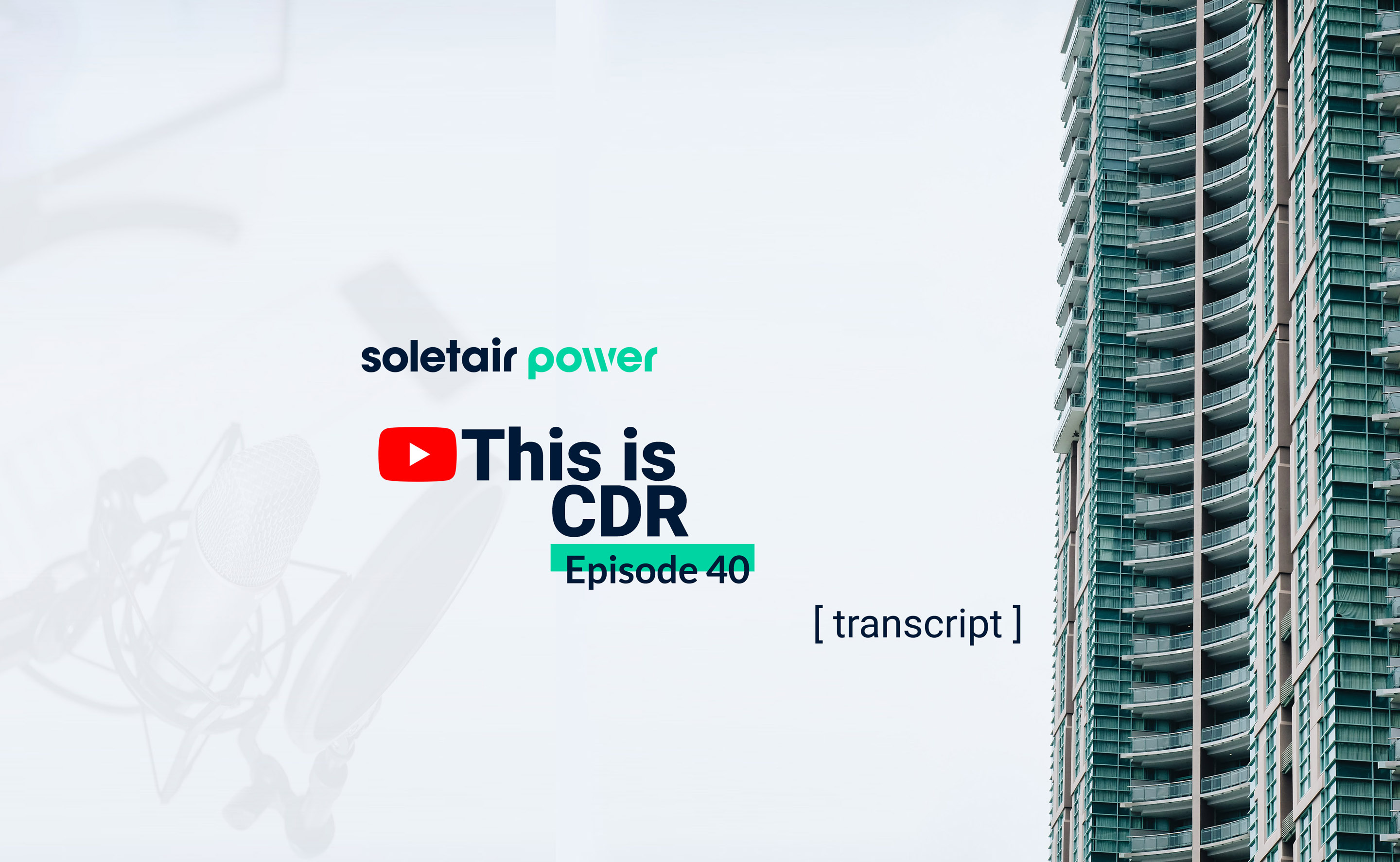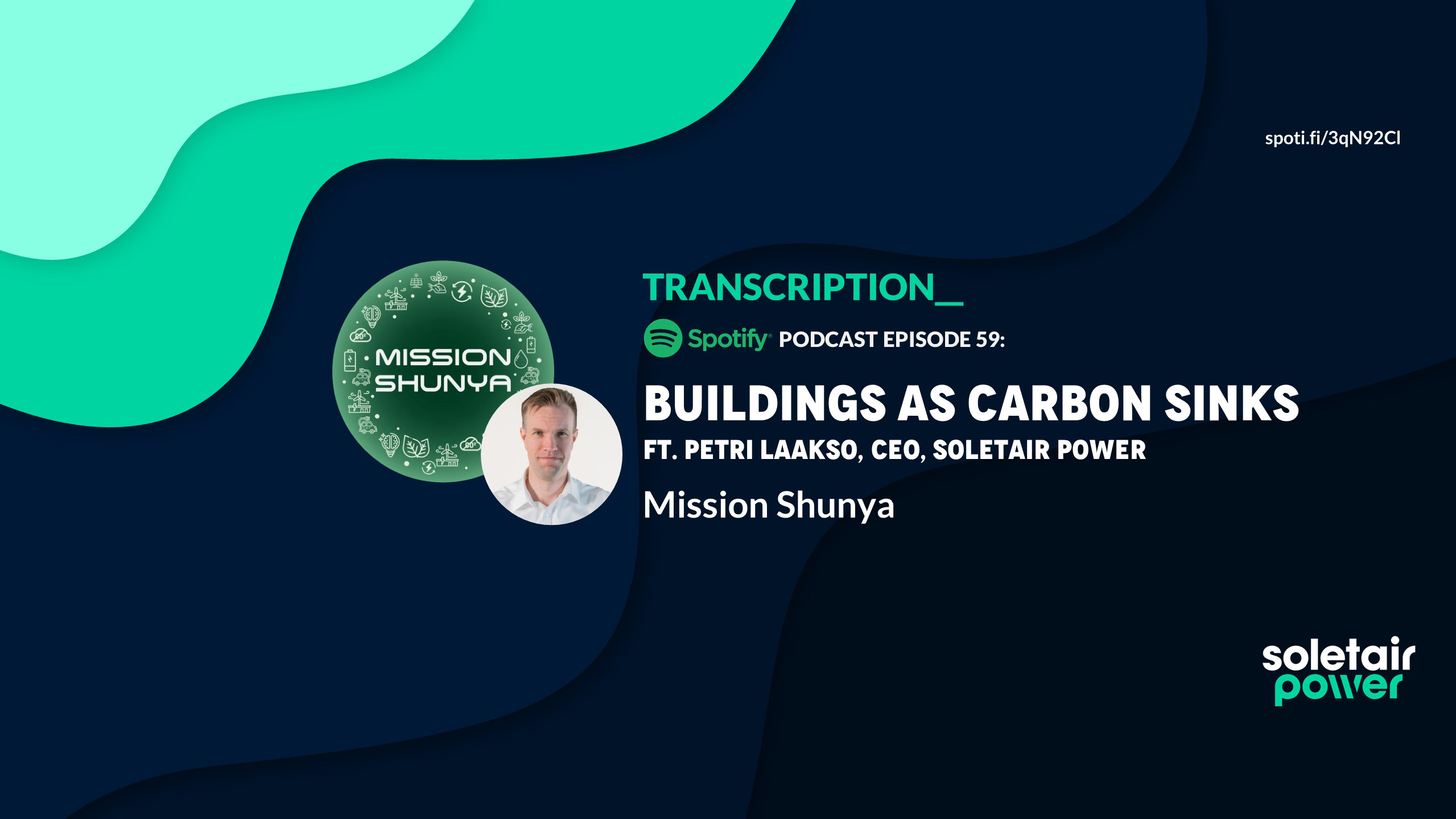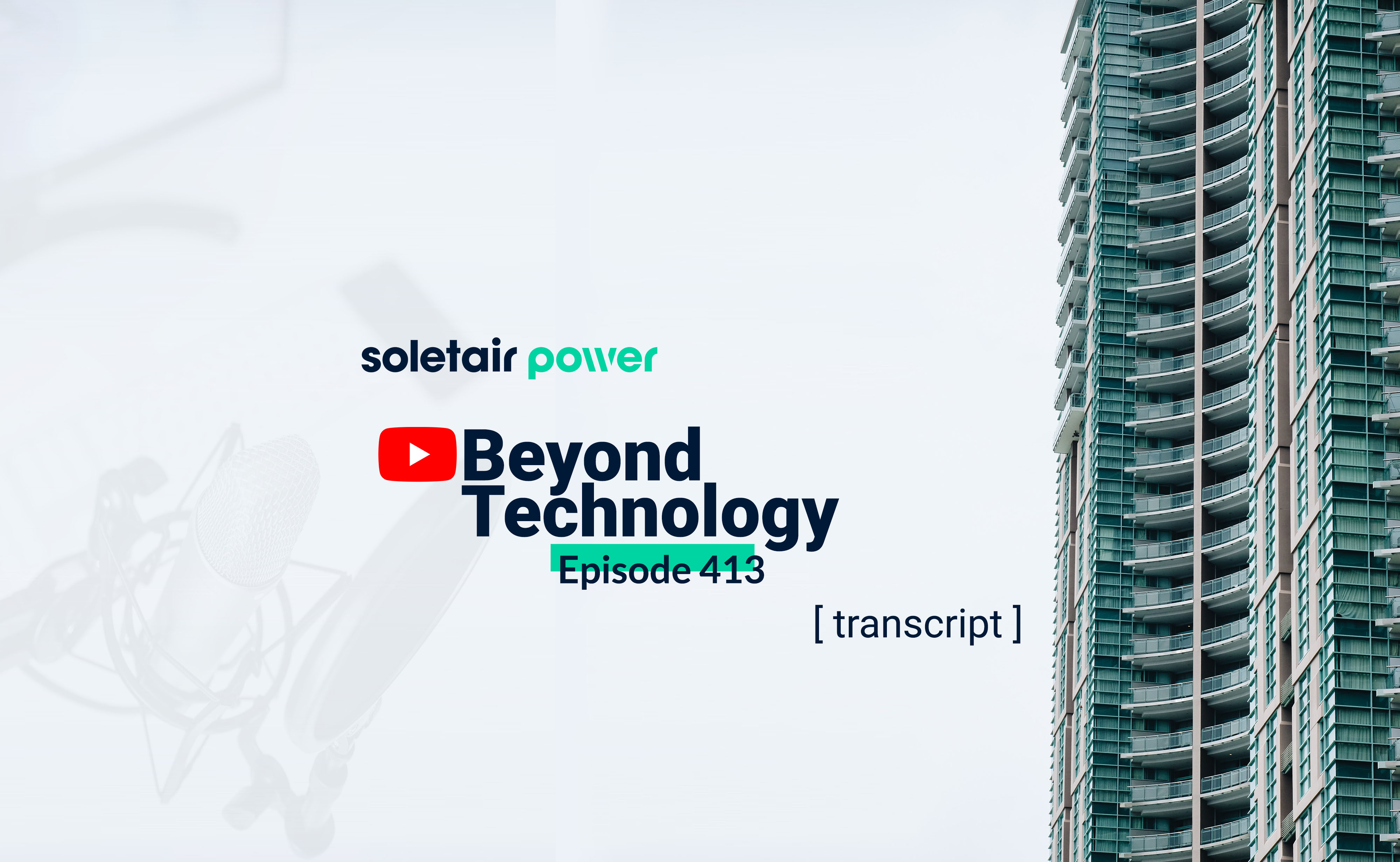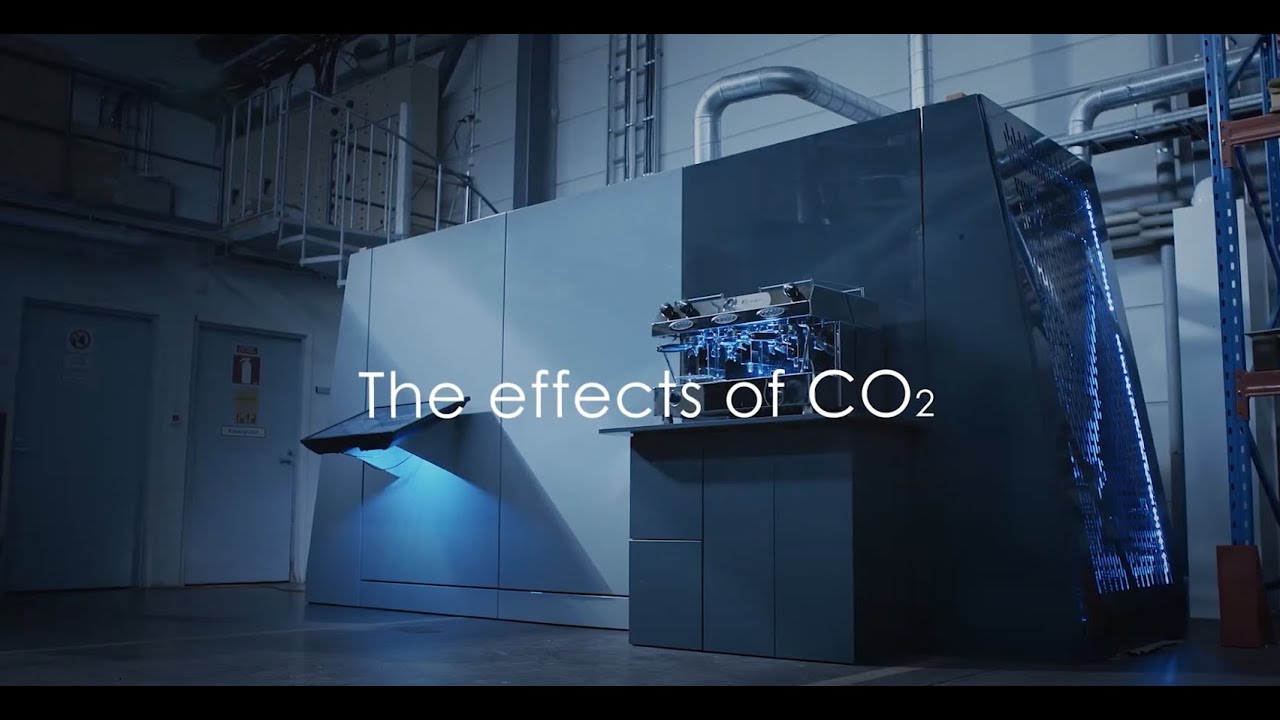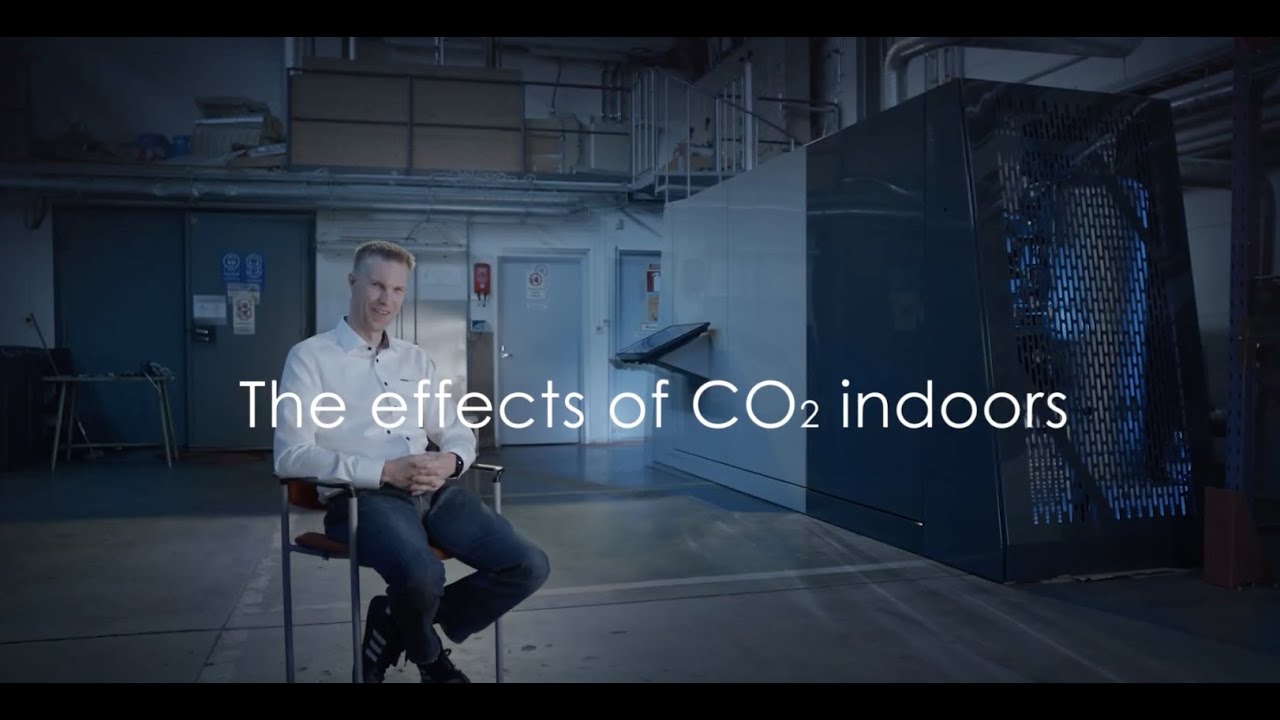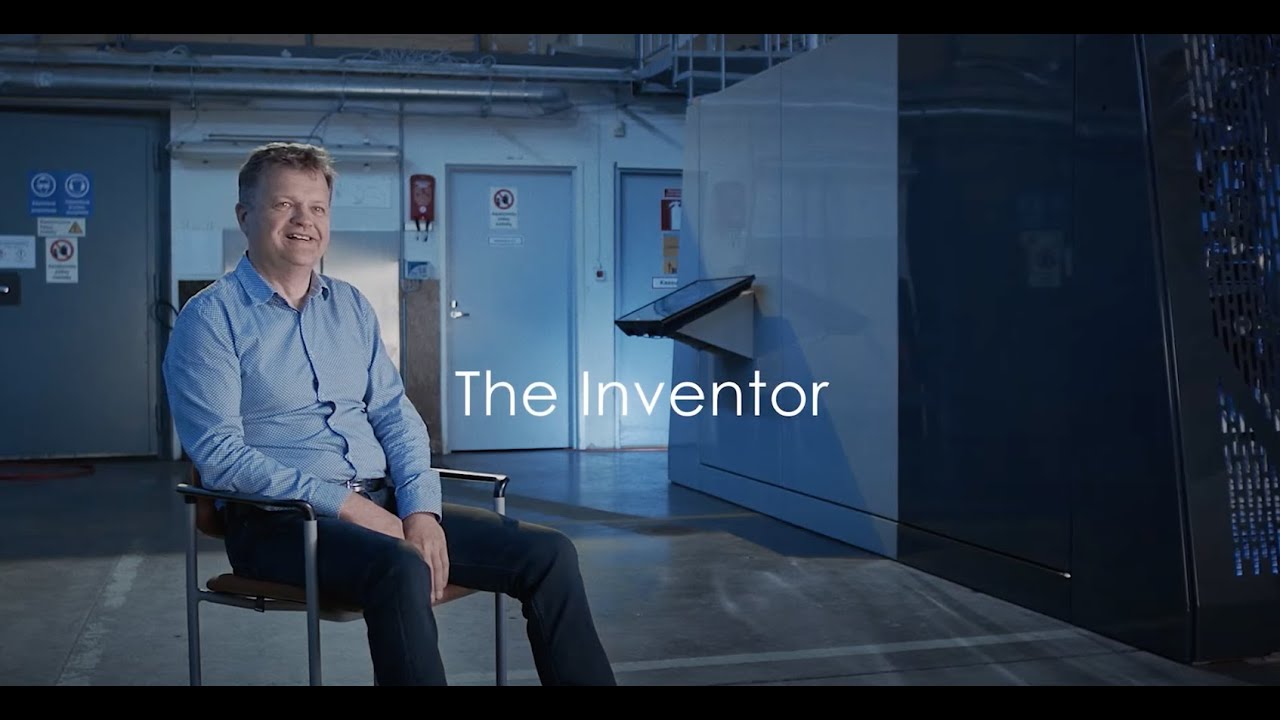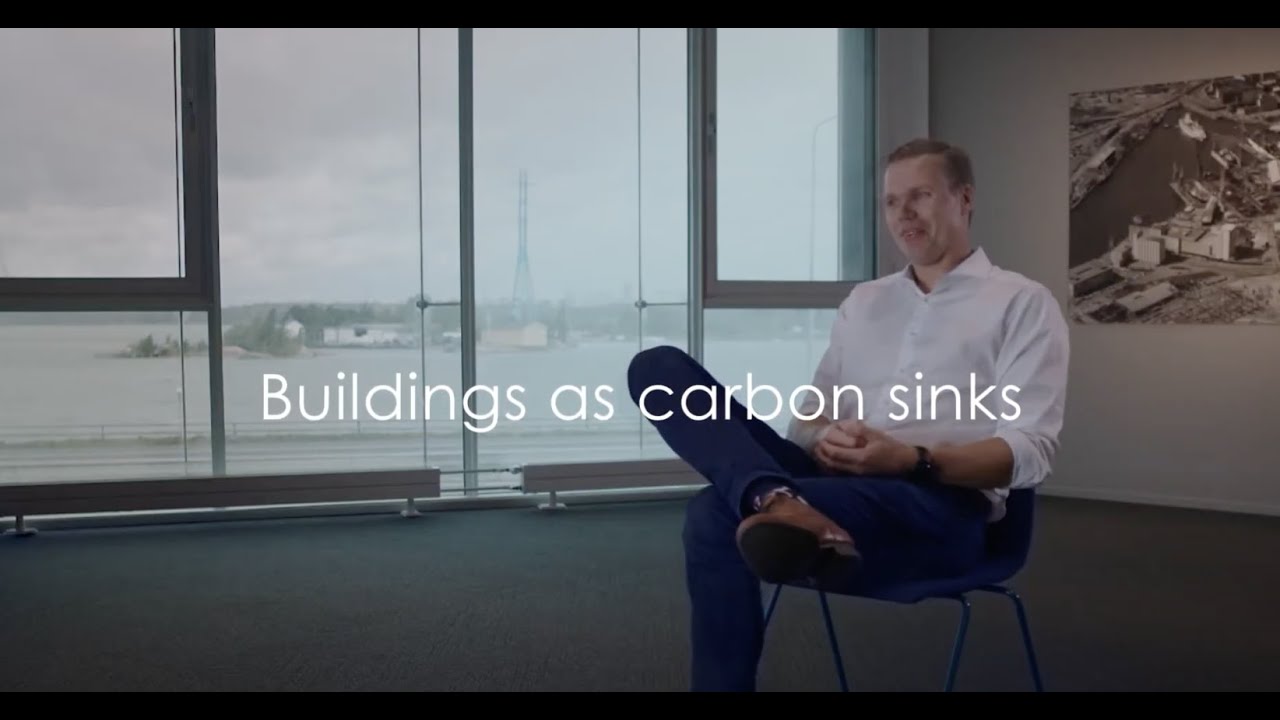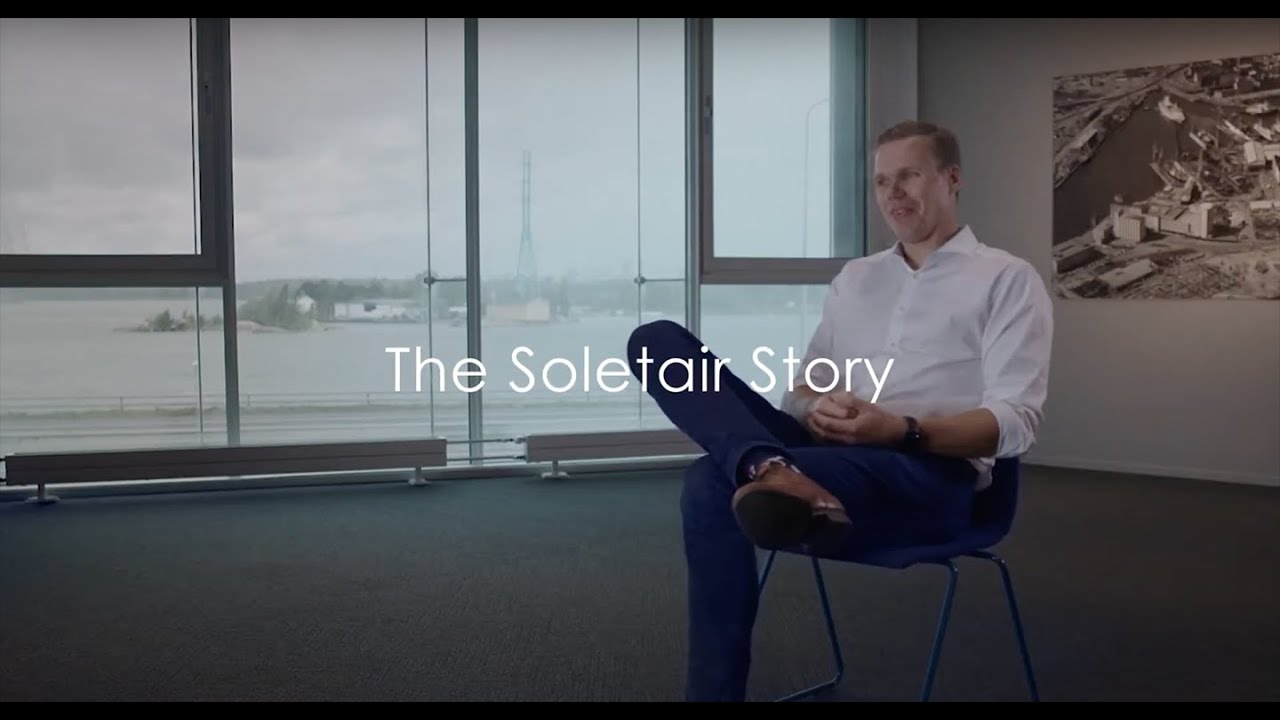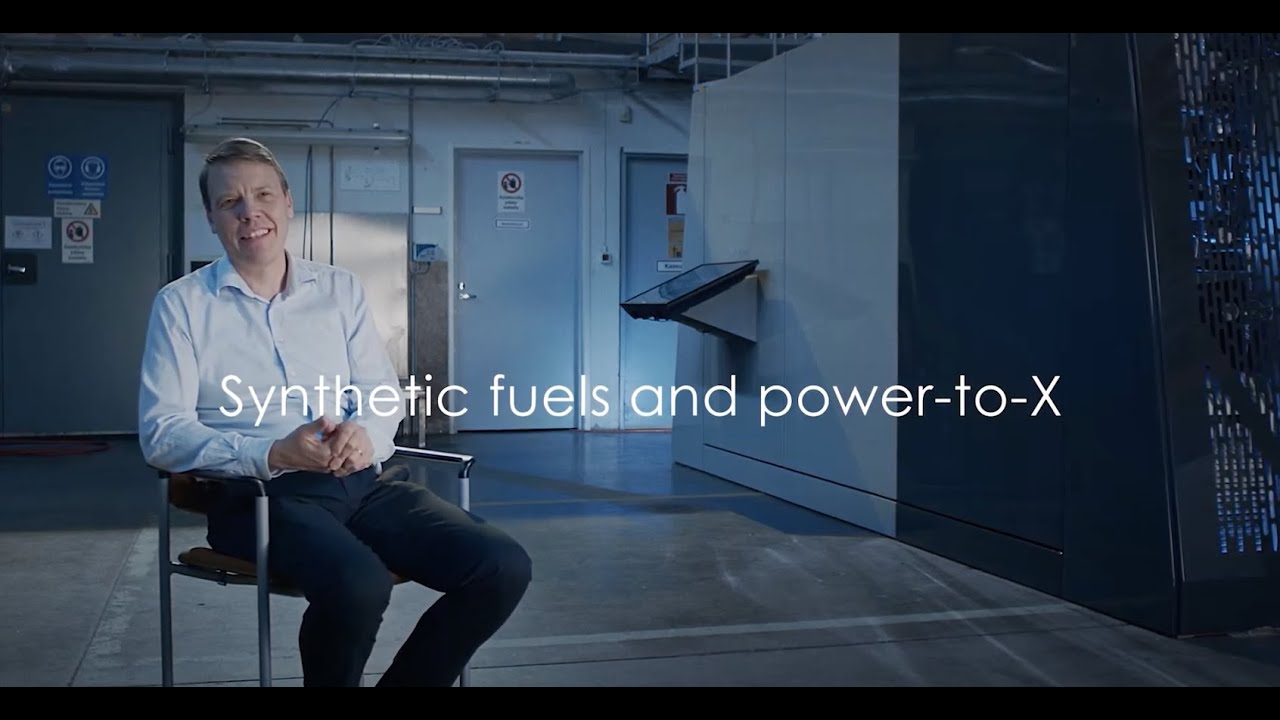This is the transcript of OpenAir’s “This Is CDR” Episode 40: Soletair Power’s DAC x HVAC with Petri Laakso, published on Jun 29, 2022.
Watch ‘This Is CDR’: Episode 40: Soletair Power’s DAC x HVAC
In this episode of ‘This Is CDR’, OpenAir’s Toby Bryce and Megha Raghavan welcome Soletair Power’s CEO Petri Laakso to discuss how Soletair Power’s DAC technology turns buildings into carbon sinks – and improves building occupants’ health, perception, and productivity – by integrating with HVAC systems to capture CO2 directly from the air.
About Petri Laakso:
Petri Laakso has been the CEO of Soletair Power since 2019. Prior to joining the company, Petri worked in the photovoltaic industry as Vice-President of Projects at Valoe Oyj. Before getting involved in cleantech, Petri worked at the VTT Technical Research Centre of Finland, where he focused on developing advanced manufacturing methods such as laser processing and 3D printing.
Transcript of the Podcast:
Welcome, everyone. Pleased to have you with us here today for our 40th episode of This Is CDR. This Is CDR is an online event series presented by OpenAir to explore the wide range of carbon removal solutions currently being researched, developed, and deployed and to contextualize them for policy proposals. Open Air is working on advancing in New York and other states and jurisdictions.
Everyone, please feel free to introduce yourself in the chat if you haven’t already. My name is Toby Bryce, I’m based in Brooklyn, New York and I work on carbon removal policy advocacy and market development for OpenAir. Just some quick background on OpenAir if you’re not familiar with us. We’re a distributed volunteer network dedicated to the advancement of carbon dioxide removal (CDR) solutions essential to solving the climate crisis. Our growing global community collaborates on shared “open source” missions in the areas of policy advocacy, R&D, and CDR market development. There should be a link in the chat to a forum where you can sign up to join our group and please do so we have lots of work to do and we also have a good time doing it so I would love to see you be part of OpenAir.
Before we get started with today’s This Is CDR session, we think it’s important to provide a definition of what we mean when we say carbon removal and carbon removal is and this is the definition from the CDR primer which is very similar to the definition that’s used in the IPCC reports:
Carbon removal is a purposeful anthropogenic activity that removes CO2 from the atmosphere and durably stores it in geological terrestrial or ocean reservoirs or in long-lived products.
There are two really important things to talk about upfront when we talk about carbon removal.
- Number one is to disambiguate it from what is commonly called carbon capture which is capturing CO2 from a point source emission like a cement or natural gas plant that’s a form of emissions reduction and may or may not be a good thing depending on the circumstance but it’s not carbon removal, which again is removing CO2 from the atmosphere.
- Number two carbon removal is in no way shape or forms a substitute for reducing global emissions as quickly and as completely as possible that is absolutely essential, we really need to focus on that from a policy perspective and everything else.
That said there’s clear scientific consensus that expresses most recently in very stark terms in the IPCC ar6 working group 3 report that carbon removal will be required at gigaton scale by mid-century that’s billions of tons per year for us to have any chance of limiting warming to 1.5 or 2 degrees Celsius. And that carbon movement will be required both to offset the hard-to-evade emissions- emissions that we cannot reduce or eliminate in a climate-relevant time frame and also eventually we will need carbon removal in the second half of the century to draw down the tremendous excess of anthropogenic CO2 that is already in the atmosphere to restore our climate to a safer and healthier state. So, carbon removal is an essential solution, but it must, you know, work alongside the priority on emissions reductions in our climate toolkit. There’s an icon in the bottom right of the slide for the carbon dioxide removal primer which is a great resource online. It is peer-reviewed by 50 plus CDR experts that kind of provides a great overview of carbon removal. This series again, we’re at our 40th episode, so you can learn a lot by watching past This Is CDR episodes, there should be links to both of those things in the chat. And today where I’m going to learn more about carbon removal and I’m going to hand it over to my colleague Megha Raghavan to introduce today’s session.
Hey everyone, I’m Megha. I’m an OpenAir member in London. I’m leading from policy advocacy at birth in California where I’m from. So, the usual housekeeping notes: Our format is going to be a quick presentation of about 15 to 20 minutes followed by a few prepared questions and then moderated audience Q&A. So please type any questions you have into the zoom Q&A box. Note that that’s up from the chat box so please find the right one to help us organize and sort of manage the questions. The event is being recorded so we’ll send the video link out to everyone who registered, and we’ll also post it to OpenAir’s website and YouTube channel and now for the main event.
So, this week on This Is CDR, we’re very happy to welcome Soletair Power CEO Petri Laakso to tell us how the company’s Direct Air Capture (DAC) technology turns buildings into carbon sinks and improves building occupants’ health perception and productivity by integrating with HVAC systems to capture CO2 directly from the building’s internal airflow. Petri Laakso has been the CEP of Soletair Power since 2019. Prior to joining the company, he worked in the photovoltaic industry as the Vice President of projects at Valoe Oy and before getting involved in cleantech, Petri worked in the VTT Technical Research Center of Finland, where he focused on developing advanced manufacturing methods such as laser processing and 3d printing. So, Petri, whenever you’re ready.
Okay. Thank you. I’ll share my screen, and yeah.
Petri Laakso’s presentation on Soletair Power
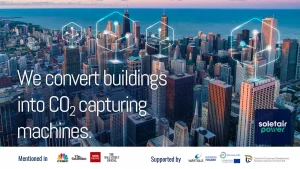
Hi, my name is Petri Laakso. I am the CEO of Soletair Power. The company is founded in 2016 and we want to convert buildings into CO2 capturing machines. Everyone doesn’t probably know that buildings are related to 39 percent of CO2 emissions globally, so that’s a huge emission source. And where does that come from? It’s of course the energy usage in buildings, whether you heat it or cool it or you have the lights on with electricity and so on. So obviously you cannot stop utilizing that energy, of course, you can improve it but you cannot completely stop it. So, this is why you need to do negative emissions in buildings. Since the CO2 is already moving why wouldn’t we just capture that CO2 away?
Our company was founded in 2016 by Mr. Ari Piispanen and Dr. Pasi Vainikka. When the local university professors wanted to capture CO2, their goal was to capture it from a point source. But Mr. Piispanen pointed out that what if we could deliver a system that captures CO2 directly from the air. The professors said that if you can make one and if it’s cheap enough, they will buy it, and that’s what happened in 2017 when the delivery was done. Then it was found out that the capture cost is somewhat high as their capture cost is and the founders were thinking that how can we make this profitable, in a way, that we don’t need just subsidies. And Mr. Piispanen had an idea “Hey, let’s combine direct air capture and building ventilation, and this way we can make it profitable already today. That’s what happened, and we got seed funding in 2019, and I joined the company because I wanted to be part of stopping climate change. And the last three years have been really a roller coaster when we have been developing systems and making deliveries and so on.
So why are we actually doing this? Well, everyone knows that the CO2 in the atmosphere is causing climate change and the only way to reverse this is to take the CO2 out from the atmosphere, not just limiting point source emissions but we need to lower it down and in this direct air capture is one of the technological means that you can do so.
And since the CO2 is affecting us people I mean since the CO2 is affecting nature, it’s also affecting us, people, if we look at scientific data, this is from Harvard; NASA has made similar studies and many other institutes also, that when the indoor CO2 level rises because of the human exhaling indoors, we will lose like part of our cognitive function because of the CO2. Easily everybody probably remembers being in a meeting room full of people probably pre-covid that the air is a little bit stuffy, and you cannot really think straight, you need to get a cup of coffee to get things straight again. But actually, the problem there is the CO2 concentration in the air and if there would be a solution to lower the CO2 level down, we could make people perform better in their jobs.
Our solution is that we would turn buildings into carbon sinks by capturing CO2 from building ventilation so that we would integrate it into the building ventilation and increase people’s performance making those important negative emissions in buildings remember that 39 percent which is possible by removing all the emissions in buildings and then we can also turn that captured CO2 into valuable products, like fuels or something else. Of course, if you make fuels, they are not eligible for carbon credits, but making concrete, for example, is a good example of utilizing CO2 in a way that we make negative emissions. Our company contributes to three sustainable development goals that you can see here on the lower right (SDG 3, 11 and 13).
Well, how do we do it in buildings, of course, there are different ways to connect to the building ventilation typically here on the left we have like outdoor air fresh 415 ppm. During the office day, we will push the air through our CO2 capture device, and we pre-compensate the air by lowering the CO2 emission. This way people can be performing much better than they could be without our technology. We can also connect to the recirculation channel of a building here in the Nordics we are based in Finland we don’t have the recirculation because the regulation is basically prohibited in that. But for example, in the U.S. there are a lot of air handling units that are just cooling down the air and in that duct, we can also connect. Or if we can maximize the amount of CO2 captured without making the indoor air benefit, we can put the CO2 capture system into the air exhaust from the building. So, there are different ways but the one that we’ve done already now is the intake side of CO2 capture. Buildings are pretty good places for CO2 capture to be in because we can be in the symbiosis with the building infrastructure you have heating available, you have electricity, all the infrastructure is there already, and you can loan the heat from the building and give it back and after capturing the CO2 you can put it in a buffer tank for taking it away from the buildings or then you can even make fuels within the building, for example, creating renewable natural gas which you can put into the gas pipeline if such is available in the building.
This is how it looks in the building ventilation room, a machine room. Here on the lower left the air is entering the building going through the ventilation machine it’s filtered heated or cooled and then pushed into the building but before we push it into the building, our device is there, and then we push the air into the building with the low CO2 levels. This is actually a really good position to be in because depending on where in the world you are it could be that in the Summertime in Dubai it’s plus 50-degree Celsius. In the Wintertime here in Finland, it could be minus 35-degree Celsius outdoors. But then in this place after the ventilation units, it’s always plus 20-something Celsius which creates high stability for the CO2 capture and also you don’t need to fight the different conditions of the weather outdoors. Well, this kind of unit is transferring 300 liters of air per second, so we can capture like 50 kilos of CO2 per 8 hours, and this is like 20 tons a year, which means that it’s an equal carbon sink to three hectares of forest. And, here in Finland, for example, in this building that I’m in, the typical emission from these office buildings is like 20 kilos of CO2 per square meter of floor space per year, and this device of ours can capture like 10 kilos away. So basically, we can lower the CO2 emissions in a building during its operational lifetime in half. And if this building’s owner would change to utilizing renewable electricity, we could create a carbon sink in the building because the CO2 emissions on the operation are smaller than what we can capture from the building ventilation.
Here is one actual example if we put our system into the ventilation system of a building. So, without our system in meeting rooms, the CO2 level can go about 1000 ppm. Remember that -20 to even -40 percent cognitive function level. We can keep the CO2 level below 600, which makes people perform much better in the offices.
Then if we kind of expand this. One building could have up to 20 ventilation units or even more. If we expand this to one city like Tokyo in Japan, there’s a lot of commercial real estate available and if we would make a massive roll-out of our technology, we could capture 6550 tons of CO2 in a single day, and if we would turn that into synthetic natural gas we could get like 2.2 million kilos of that from that same CO2. So, you can really start making big numbers if you make a wide-scale deployment.
We have two business models in which we operate. Of course, the easiest one for a startup is to sell the equipment and technology as such for buildings or even outdoor capture. I will shortly show you our latest delivery to Germany how it looks like there, and how it operates. And of course, there’s a cost-plus a model plus the after-sales, even though our system needs quite a low amount of maintenance it can run like 10 years without any absorbent change or anything, there could be some water circulation pumps and these kinds of things that normally it’s needed to be replaced when they fail. The second option is of course if we install this in buildings and we make the installation so then we could sell this as a service of best indoor air for the tenants in the buildings, and the cost could be like one to two dollars per day per employee and this way we can then own the CO2 together with the building owner and sell it for somebody who will need it or somebody who will make a permanent reduction from the air and then get the carbon credits also and in long term, this sales as a service will be the best money yielding machine and of course, for a customer, it’s also a lower technology risk because if the service doesn’t work they don’t need to pay.
Market size is huge because of course there are a lot of buildings out there and already there are so many buildings which are going to be retrofitted in the future and we think that our technology, or let’s say the direct air capture in the buildings will be standard as normal ventilation units in 10 years’ time. So, the market is massive, and we are just about to kind of launch the market through the reference cases that we’ve done already.
Of course, there are other companies doing similar activities and then several others not listed here are doing different kinds of darker capture things. And we are offering technology and equipment for those who will want to capture CO2 directly from the air. The other ones are basically, these mentioned here, will want to capture a lot of CO2 outdoors, as much as possible, and sell it as CO2 mitigation as a service, but we want to offer technology and equipment for those who want to utilize it. And this way creating in buildings negative emissions. And our systems are fairly small and of course, through modularity, we can make bigger ones the small ones are affordable so even today everybody can kind of afford to have one system and they don’t need to invest 100 million for one system.
So, we have four different product categories first one is of course the building HVAC-connected device which can be retrofitted to any building to any ventilation unit size. The second one is the outdoor capture module – this is a containerized module that can be delivered anywhere in the world, and you can combine several containers to get higher performance. The third one is a single room like a meeting room problem solver so that we can capture CO2 directly from the air within the building. But that doesn’t make a permanent reduction of CO2, it will just temporarily stop the CO2 and during the night it will release the CO2 away to be ready for the next day again. So, the replacement air takes the CO2 away during the nighttime, and it’s ready for the next day to keep a low CO2 environment for people. We delivered Dubai World Expo a system that was a Power-to-X, you can see a part of that unit here. So, if somebody wants, we can deliver a system that creates fuel from the air, for example.
Here is a picture from yesterday. We started installing the system there in Germany. It’s a containerized unit to capture CO2 and you can put several containers. Here customer wanted to have only one. Maybe the beauty of this is that it’s giving a really low noise – it’s like 50 dB and it has all included in that. So it’s creating 50 bar CO2 from that unit for the customer’s application.
Somebody’s always asking me hey after you have captured the CO2, where do you utilize it? Well, all in the cases that we’ve done so far, the customer will utilize the CO2. Of course, there’s a wide variety of different kinds of applications in which you need CO2 and especially this green CO2 is really something that when the hydrogen economy is getting up, they will also need to partner up with the green hydrogen, the green CO2. Last year in the UK, there was an odd situation when the local fertilizer plant stopped using natural gas so there wasn’t a byproduct of CO2, so the CO2 price went skyrocketing, close to 600-1000 euros per ton and this is why the government was putting subsidy on that company so that they would start producing fertilizers again so that there’s a feed of CO2. So, when the natural gas usage is not there anymore, there’s no feedstock for CO2 and then the utilization of green CO2 will be really important. But of course, taking CO2 completely away from the atmosphere is the bigger goal for everyone.
We have a patented technology – seven patents and one already approved in the U.S.; it was last December. So, we think that we have a pretty good market position at least in the Building Direct Air Capture side.
Here we can see some projects that we made. So the pilot unit, which I already explained in the beginning, then the Power-to-X delivery to Dubai World Expo. It was pretty nice exposure for us, creating fuels on-site at the Dubai world expo. Now, this delivery to Germany is just about to be finished. We are building one building installation system here in Finland and at the end of this year, we should deliver a system for a customer here in Finland for a foreign application that the customer will utilize CO2 as raw material.
The team behind the company at the moment is that there is the core team of four of us and then 11 other great people to work towards a winning team in the direct air capture business and currently we are looking for series A to really expedite the growth of the company.
Our long-term reason is that through a massive rollout of our technology, we can let’s say in five years, start to capture a serious amount of CO2 away from the air with our customers.
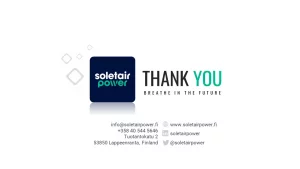
Thank you for your time today and happy to answer any questions that you may have.
Thank you so much, Petri. It’s very exciting for us to hear from a CDR and particularly direct air capture company that’s actually out in the world deploying of which there are very few as we know so congratulations on that it’s really great to see. We usually start our Q&A by asking presenters about their personal and professional journey to climate and to carbon removal. You talked a little bit about your professional trajectory, but maybe could you talk a little bit about you know coming from where you are, where you sit in Finland, when did you start becoming aware of the climate problem, and then when did you start becoming aware of carbon removal and kind of how you got your mind to where it is now.
I was long-time a researcher in the national research institute and then there was an opportunity to join a renewable photovoltaic company here in Finland and I was thinking that well this is something for the future and I can really make a change because we were developing a certain type of a solar cell and a panel for the market completely something else than what the, for example, Chinese are doing. So, I saw that as an opportunity but then I was working there for three years and this opportunity came up that I was able to join a company that would be doing a really radical application. So, taking CO2 out from the air and I was thinking that this is the thing that I can really make a change, because a small photovoltaic company from Finland might not be the winner in the game in which the Chinese are kind of mastering at the moment. I knew the founders before and really saw that there’s a personal opportunity but also an opportunity to change the world. That’s why I wanted to join the company and at that time that point I really understood when I started studying that hey the CO2 level when I saw the graph (that I was showing you guys on the second slide that I showed) that man! This CO2! It’s going straight up! If we don’t do anything! And I was just earlier thinking that, well, we can change that but, in this company, I have really realized and also realized that the buildings are the biggest amount of CO2 producing in the world currently. So, there’s a huge potential to lower it down with of course together with our technology but with all the other technologies because electrification for example is a good start for buildings.
Oh, got it, thank you. Another sort of not a question, that’s not specific to Soletair Power, but you know, you live in Finland and very strikingly, Finland recently announced a very ambitious national climate policy. I think it was to be net-zero by either 20 I think 2035 and then to be net negative by 2040. I mean that’s super; I think it’s the first net negative commitment that I feel like I’ve heard of. Can you talk a little bit about that and I’ll put a link in the chat, I think a pretty good overview journalistic of the commitment, but as a Finnish citizen and as someone who works in the climate and carbon removal sector in the country, can you talk about your reaction to the commitment and sort of in general to the what it means and then also like how realistic is it and how will Finland you know because it’s one thing to set a target to play another to actually achieve it?
That’s a really ambitious target and we need to have a target so that something happens because if we put the target on a lower level that’s the target that we are aiming at. But if we put it on a higher level then that’s the target we are aiming for, and we might be even achieving that. But it was a couple of years ago when I started looking at that that how do we actually going to get there because even earlier there was the discussion and in Finland, they kind of calculate in a lot of benefit from the forests that we have so the forests are absorbing a lot of CO2. So, in the calculation, we are utilizing that. But I think that in order to really reach that goal, there need to be a lot of investments in renewable energy creation and in all sorts of kinds of technologies like direct air capture. So it’s not going to be easy. But I hope that Finland will be a role model for everyone, at least trying to do that.
Yeah, I mean I hope so too. It’s very but it was very exciting to see, and the ambition is quite admirable, I think. Back to Soletair Power, I want to talk a little bit about some of your sort of high-level techno economics. I’m going to put a couple of links in the chat. Peter Minor from Carbon 180 wrote a really great blog post. I guess it was late last year at this point about what he called DAC 2.0 and another link is from a friend of OpenAir Na’im Merchant about modularity in DAC, but can you talk a little bit about Soletair Power’s process in terms of a couple of factors? Number one: you seem to have some sort of functional innovation based on how your deployment model in terms of how your air contact the air just be via building HVAC systems and how those feeds into maybe potentially increased energy efficiency in terms of your process. Can you talk a little bit about that? And then I have one or two follow-ups.
What’s kind of unique in our system, at least what we think, is that we have a really low pressure-drop over the system. In building ventilation, you cannot have compressors and these kinds of things you just have to have the normal fan that blows the air through, so that we can capture it. Second is of course that you need to be safe for people otherwise you cannot push the air into the building so that is also there it’s certified by the national health and safety organization here in Finland. Of course, the assortment that we are developing is we think that it’s really good. It has a good efficiency in performance and also in energy-wise but it’s clear that we need to take it a couple of steps forward so that it can be even more profitable. Typically when you go to media, you see Direct Air Capture unit – being out there – having huge fans. And if the fan is running it’s going to make a huge noise. The thing is we don’t need that huge fan, because of the low-pressure drop. For example, the German case that we delivered yesterday, needed to be less than 69 decibels, but actually, one meter away is 50 decibels and the guys were trying to measure the noise level today, but the machine – three meters away – was doing 72 decibels, so we couldn’t really track our system because it’s below 50. So, it can be really low noise also.
And we’re probably our process fundamentally intermittent meaning it’s not running 24×7. And that’s when the cycling process so that we push the air through and then we close the vacuum valves and use a thermal temperature swing with a vacuum step and then we can get like 99.9 percent pure CO2 out from the system so you cannot run continuously.
And okay and so of the 24 hours like how much of that time are you in operation and how much of that time are you in desorption and or sorry capture absorption and then and then does that batch nature of your process lend itself to being powered by intermittent renewable energy in any sort of advantageous way?
Of course, those times can be adjusted like the German case we needed to run everything in 12 hours, the capture, heating, cooling, taking out the CO2 in the building case the typical kind of capture time is from the morning when people come to the office until the evening when people leave the office. So, we can make it faster or slower the capture process. But of course, it would be advantageous to have a 24×7 kind of capture but with our device it’s cyclic. And typically, it could be like 12 hours of capture and 12 hours doing the whole other thing or we can do several cycles a day but then it depends on the application which is the most advantageous if you want to capture the highest amount of CO2. But in building applications, it’s not always the target to capture the most amount of CO2.
And in building applications, you talked a couple of times about how you leverage existing building operations both the air circulation from the HVAC and potentially a heat resource. Does that make your process more efficient? Does that give you a competitive advantage in terms of energy requirements and can you talk a little bit about it? I guess its range would be depending on whether it’s outdoor or indoor but the range of energy requirements for your process per ton of CO2 captured?
We say that our energy consumption is between five and ten-kilowatt hours per kilo per ton is like megawatt it’s megawatts then not kilowatts but what’s advantageous in being a building basically like I said earlier in the presentation that if you are in Dubai and outdoor air is really hot so then probably the temperature swing doesn’t work that well if you are at 50-degree Celsius. But if you are in a building, it’s 20-something every day so it’s advantageous for the highest ability for CO2 capture. The same applies here in Finland when it’s really cold in the wintertime, it might be difficult to capture the CO2 with similar technology to ours because the machine starts to freeze out unless you hit the air and that would be completely stupid during the winter so that’s probably the thing in which we have a kind of advantage over the other ones.
And so, you said five to ten-megawatt hours per ton?
Yes.
Okay, that’s the range and it would depend on some of the specifics you were describing it’s also I have to say it’s great to hear you talking about the actual specifics because direct air capture is a physical process that is strongly impacted by its environment and a lot of times you hear people talking about direct air capture as a sort of platonic ideal, whereas you’re out, actually out in the field, deploying from Finland to Dubai, and it’s a very different set of techno-economics and process.
Yeah, and of course depends on what is the size of the system. If we would make substantially bigger systems, then we can go to lower energy consumption but these are fairly small systems like a container size and like the small one that we had in Dubai, it was generating only less than two kilos of CO2 per day. So, then the energy consumption is much higher than if you would capture one ton a day and our kind of road map for the next couple of years is of course to lower the energy consumption – much much lower. And if there would be a solar thermal available we could utilize that, if there would be surplus heat available, we could also utilize that, because we are utilizing temperatures below 100-degree Celsius.
Got it. Briefly, you’ve referenced this in a couple of contextual points in your presentation. But can you talk a little bit about how you think about modularity that’s a point that both Peter Minor and Na’im make and the links I posted but both modularity in terms of the form factor you’re in a container and the parts that you’re using to build are using bespoke parts that you have to buy yourself or can you actually purchase them out in the open world and sort of modularity of supply chain, like how do some of those things feed into yours?
Our direct air capture system has a certain module and then we just add modules to make a higher performance, and then you can have several units. Because for example if you want to utilize the heat from the first unit to the second one, you just run them in a different cycle so that you can just circulate the heat to the next one, and to the next one, and to the next one. So that’s one thing and the direct air capture module is we have been simulating that a lot so that it’s our proprietary design. So, of course via subcontracting the manufacturing of that but it’s not something that you can buy off the shelf from somewhere. And the key component inside the module is something that we use in all our devices so that there are several of those inside one module and more in one unit itself.
Got it. The last question for me and then we have a bunch of great audience questions in the chat, sorry in the Q&A box, please Q&A box and thank you for those, and please keep them coming. Can you just talk about your … we’ve talked about … scaling quite a bit and modularity? Your module, I believe, I heard, is approximately 20 tons of annual capture per module for a container-sized module. Indoor is smaller than that outdoor, and then can you give us a vision for both how the company will scale between now and let’s say 2030 in terms of how much CO2 you’re capturing and also how you think your systems will evolve? Will you continue to be shipping single containers to individual buildings? Do you think the systems will get bigger, so you’re kind of getting more economy of scale per deployment? Just talk a little bit about that. That would be great.
If we first speak about this building side the ventilation units are, let’s say in one cubic meter of air per second, up to 10 or even 25. So, those are fairly small if you start capturing CO2 in huge quantities. So that’s why we have a certain module for that range so that we can just add modules and cover the whole spectrum of that. But when we go to outdoor capture where you can blow as much air as you want because in buildings you are bound by the air volume that the ventilation unit is handling. So then you can make substantially bigger modules and our target is to build a system a module that can capture like one ton a day. Now it’s like in the range of 50 kilos a day. It’s pretty straightforward how we are going to do that of course we need a better absorbent which we are developing plus how we kind of construct the module itself. and on the outdoor side, I think in 2024 we should have a system that can capture at least 3000 tons a year. So that’s a target for 2024 and actually, there’s one customer already let’s say a potential customer that would like us to do such a device in 2024 so that’s why we are kind of going towards that and of course lowering the energy consumption also. And then and the perspective 3000 ton per year outdoor module how many containers will that be in terms of its physical size well my reason is that we would have eight modules, so maybe it would be like eight to ten containers.
Eight to ten container-sized modules?
At this point of course it’s really difficult to say when we actually make it that is going to be that. But at least the design should be that size whether there are single containers or you kind of combine them into one pile of containers.
So, you envision in the next three to five years being at a scale, a container size module whether it’s put together with others or not would be doing a ton a day approximately.
Yeah, roughly, “a container-a ton-a day”, something like that.
Got it. Okay I mean I have many more questions, but Megha are you here? Yes, yep, I’m here. Cool. So Megha’s going to take over and ask some audience questions and so yeah, so, we had a few questions just on some of the technical aspects. So, people asked, can you just talk a little bit about the capture mechanism and then also is it you know pressure swing, temperature swing, what kind of tech are we talking about here?
Yeah. It’s a solid sorbent. If you go to our YouTube page you can see the sorbent there, our CTO is explaining how the system works what’s the solid sorbent temperature swing and when we use a vacuum step, we can get pure CO2 out from the system.
Okay got it and are you able to attach your device directly onto some of the existing HVAC systems and buildings or is there a major retrofit with you know bigger fans or other equipment that you need to do?
No, we can do it straight retrofit to buildings. Whether there’s just space for our system because in some older buildings the ventilation unit might be in a small room and there’s no additional room for that but as we can also put it on the roof next to air handling unit for example then there’s much more space available. In some buildings, for example, we don’t need any additional fan even, which is it’s like an add-on filter to the building ventilation unit. You just boost a little bit the building ventilation units’ fan and then it overcomes the small pressure drop that we have on the system.
Yeah, okay, and then just I think you mentioned that being sort of a cyclical process with the capture versus desorbing someone asked if it’s possible to run two units in parallel so you’re always kind of like capturing while the other is desorbing and vice versa or is it is that even the limiting factor on the kind of your capacity?
Of course, that’s possible to have two or even more, but it depends of course on what is the goal of the buildings probably. If you want to keep the CO2 level at a certain level, then it’s probably wise to have two units. If you need to keep the airstream 24×7 at a certain level, then you need two units but normally people are only in offices during the daytime, so 12 hours a day is just enough for capture. But yeah, it’s possible to combine several units.
Okay got it, and then just thinking about kind of what happens to the product of that one of the questions we got was you know since a lot of buildings might have pipelines and for things like natural gas is it possible to repurpose those pipelines to then you know as people maybe move away from using fossil fuels to repurpose some of those pipelines to ship the CO2 out and kind of have more options for what you do with it?
Yeah, if it would be possible to turn those gas pipelines for CO2, then for sure it would be a really good way to do so, but I don’t know how soon that will happen. Because of course the fossil fuel manufacturers and distribution companies won’t utilize their gas grid as it is, so, that’s why, three years ago, we already introduced a model that would create synthetic natural gas in the building, and you inject it into the pipeline, so you don’t need to transport the fuel away. But that might not be the best possible utilization way for the CO2. And especially if you want to make negative emissions in buildings, then it’s not eligible, but yeah, existing infrastructure should be utilized to the maximum if possible.
Okay, yeah, and then thinking about other you know uses that might keep the CO2 in the building or use other methods than trying to use the natural gas pipelines. Could you talk a little bit about you know how much methane you produce compared to how much you need for the HVAC and what else can you do with the byproducts that don’t require tons of transportation and sort of incur more emissions that way?
Maybe the first question was how much natural gas synthetic natural gas we can produce out of CO2. Well, if you have that one unit that handles 2000 square meters of floor space three thousand liters of air per second that can produce eight hours 50 kilos of CO2 and that can be turned into 17 kilos of natural gas roughly. If you would use it in a passenger car utilizing renewable natural gas, you could drive like 400 kilometers with that. It’s a company delivery car, for example, so you can easily cover one day’s travel with that then basically having zero-emission fuel on the car.
Okay got it and I think you mentioned this earlier, but could you just talk a little bit more about the sort of efficiency or the like the amount of CO2 captured per energy use and sort of how you think about the life cycle analysis of all of it.
We are working on the life cycle analysis on the whole system; we have gathered all the data on the building installation that we’ve made in vasa, and it’s in progress. But the main thing affecting the life cycle analysis is the energy source, what kind of energy are you utilizing and what is the CO2 intensity on that one. I typically say that if we have a solar for example 20 grams per kilowatt-hour of electricity we are like 90 percent negative on the process, but if you utilize the energy here in Finland from the plug we are like carbon neutral on the process and if you are carbon neutral then I don’t know does it make a does it make sense to create carbon-negative emissions that way you need to be carbon negative so that you can really make a change and the best utilization for the energy.
Right, okay, and then thinking about other uses for this technology is there a way to translate it, or do you have any plans to think about translating it to homes or apartment buildings you know other things than commercial customers?
Yeah, the other product I had shown, the four categories, the number three is like a single meeting room unit. We are utilizing it in our office; we have a joint office here, next to my office, it’s like 50 square meters, we have six people there and the CO2 level goes to about 1000 ppm quite easily. But when we have that indoor unit there, it will suck out the CO2 quite nicely, so it keeps at 600 ppm to 700 ppm easily. We’ve been getting a lot of interest from the greenhouse industry. So, people would like to utilize that captured CO2 in greenhouses. So that would be a really interesting solution that if you would have a greenhouse on top of a building you could feed that greenhouse with the CO2 and actually those need quite a lot of CO2 there. So that would be an interesting application. I think that power to x and making fuels would be also quite interesting but of course, the quantities might not be very big if you have only a few ventilation units in a building. Apartment buildings are slightly challenging because it’s really difficult to justify the cost of CO2 capture today, but for example retrofits here in Finland, we do a lot of retrofits in buildings and then the old ventilation plan in the new building will yield a low indoor air grade but if you want to go to higher grade you need to have bigger ventilation ducts and so on. With our technology we can keep the CO2 at low levels, so you don’t need to change the ventilation ducts, it would save a lot of costs. We don’t really like to lower the ventilation with our technology even though it allows it, because there are several other means why you should also ventilate but our solution also makes it possible to lower the ventilation and keep the CO2 at the same level that it was when you started, so there is also different kinds of ideas in which you can utilize our technology and in the next five years we can lower down the price on a level that also the apartment buildings could be viable options for our business, but not probably not today yet.
Okay got it. Yeah. Someone else asked actually, “Have you thought about reducing CO2 and enclosed livestock operations where ammonia and methane are also issues as one use-case? Is that something you’ve thought about?”
Yeah, that, I’ve got that question a couple of times, and we’ve checked that, it could be possible but no implementations yet. Let’s see whether we can see that kind of thing. We have plans for next year to make a greenhouse application for a customer. It would be our technology applied in a bit different way so that it’s cheaper to use because in those greenhouses you don’t actually need pure CO2, you just need an elevated CO2 level, so, that’s probably something that’s going to happen next year.
Okay great and then this is maybe a little more philosophical, but do you see the decentralization of DAC as a challenge? You know not all users are going to have a direct use for the CO2, so then you might have to think about transportation or other logistics to move that around. So yeah, what’s maybe just your view on like decentralized versus centralized DAC and the pros and cons.
Well, of course, we want to say that it makes sense to decentralize. We cannot say anything else. But truly I think so and if you think about every city or town they have its own concrete manufacturing site, and if you could utilize the CO2 in those concrete manufacturing sites you would need to get that CO2 from somewhere. And from buildings, it would be the best one because then you can do those negative emissions on-site in buildings and the transportation distance is not going to be that many kilometers so we think that it’s beneficial to do so instead of you would be doing it in a remote place somewhere far away, and you would need to transport the CO2 here and remembering what I said in my presentation that if the outdoor conditions are really hot or really cold even the remote place doesn’t help. Because the air is so hot or cold, the efficiency is not so good. So then making buildings would make sense at least what I think.
Got it. Okay. Just a few more before we wrap up and this one, I will admit I don’t know these acronyms so hopefully, you do, but if not, we can get past it. Have you considered approaching USGBC to make this a component of the LEED certification or maybe you could just talk more about building certification generally and whether that’s something you’re looking at?
Yeah, I kind of missed that acronym but yeah, I think for us, the U.S. real estate market would be the best and our target market is in the U.S. of course. We need to make a couple of reference cases here in Europe first and then approach U.S. markets maybe a little bit later.
Okay got it and what kind of you know questions or concerns or points of interest do you hear when you talk to potential investors. Because you talk about things like more productive employees which is like a great message, but you know it’s not one that I guess it’s not like a metric people are familiar with, so how do you kind of talk about that and make that case when you’re talking to these people?
Actually, it was just pretty pre-COVID, we got an inquiry from one global tech company that they wanted to have this people-performance done on their sites in one country in the far east. So, there are companies that believe in this. But then one big thing is the real estate and the negative emissions for example in New York there’s the local law 97 in place and in 2024 it starts the effect on buildings that cannot lower their CO2 emissions and they are going to make it more strict step wise. So, our technology would be really good in helping those building owners to lower their CO2 emissions. So, I think that’s going to be a big thing in the future and for example here in Finland, whoever has the best kind of development case and then the lowest yielding CO2 emissions in a building will win a kind of the property then they can start building the building. And each and every building, kind of development company or all the owners want to have CO2, kind of a carbon-neutral by I don’t know 2040 or 2050. And how are they going to do that on-site if they don’t do direct air capture would be really interesting to know. Of course, if there’s like they use natural gas you can capture that CO2 away or there’s a company in the U.S. doing that but when you do the full electrification and even though there’s photovoltaic electricity you have a small emission and you need to get rid of that, direct air capture in buildings would be a good solution in my mind.
Yeah actually that I mean that is a nice segue into I think the last question I’m going to ask which is a bit around the policy side of things and you know you mentioned the local law 1997 in New York which is obviously a great example of cities leading on this are you seeing other examples of like not just state and national level policies but things at the urban level that are you know potentially of interest and use to you as in your company or just interesting in terms of the way they’re driving things forward and what kind of policies are you hoping to see on that front?
I think this local law 97 is really good because it doesn’t select whichever technology you are utilizing so whether you are doing this or whether you are doing that all that can contribute it’s a good one. So that it’s not just pinpointed for one special technology. And would be really interesting to see that kind of thing and I think things are going the right way and we just need to kind of have everybody joining this and not just like one city in the world but and at least here in Finland, the politicians are really good in copying different kinds of legislation and really nice to see how that local law 97 is kind of affecting here in Finland. And there was that LEED and BREEAM kind of certifications I think our technology is so new for the buildings that they are not yet kind of accredited on those and we need to show all the life cycle analysis and this kind of things but when we have those ready, I think that those will be really helping in our business too.
Great well Petri, thank you so much this has been amazing and I will hand us back to Toby to just talk about what’s coming up next thank you mega, and thank you to the audience for so many great questions and most of all thank you to Petri for being with us today really appreciate your insights and again it’s super exciting to talk to a carbon removal company that’s actively deploying your system. So, congratulations on that, and best of luck going forward in the coming months we look forward to tracking your progress and talking again soon onward. Thank you again for being with us.
Thank you for the invitation.
A couple of quick programming notes number one we open-air have an ongoing citizen lobbying effort for the federal CDRLA which is the U.S. National Federal Carbon Removal Procurement Bill there should be a link in the chat and please join that basically, we have a bunch of resources that help you contact your local national federal representatives to get them to be aware of and hopefully co-sponsor and support the federal CDRLA. From a “This is CDR” perspective, next week we are off for the U.S. July 4th holiday, and then on the 12th, we return with Seafields, which is a really interesting ocean-based CDR company that cultivates sargassum in the open sea and then uses that for carbon removal and particularly in light of some of the recent news about biomass-based ocean CDR solutions it’ll be really interesting to talk to that team they’re also a member of the ocean visions launch pad which is a manned by our OpenAir colleague and friend Nikhil Nila Kathan so it would be great to see them. On the 19th we are rebooking, and we will have an announcement there soon so stay tuned and keep an eye on our Twitter and also on your email if you’re on our email list and that will be announced very very soon. Climate robotics is coming on July 26th they’re very interesting basically autonomous robotic in-situ pyrolysis machine and one of Microsoft. Microsoft made an early purchase of their carbon removal, and it would be great to learn more about how they are approaching the biochar carbon removal opportunity bunch of great stuff coming up in august we have Carbyon which is a Dutch, Netherlands-based direct air capture company. Mask’s X-Prize milestone awardee Carbofex which is another Finnish company we are our Finnish trifecta with Puro.earth, Soletair Power and now Carbofex. They are doing biochar at scale and we’ll have a lot of other announcements coming up soon so thank you for being with us I put a note in the chat if you happen to be in New York and you haven’t voted yet we have a primary election I’m happening today and literally those elections can be swung by a handful of votes so if you haven’t voted please vote and we will see you in two weeks with Seafields. Thank you so much, everyone. Have a great great day.
[Music]

